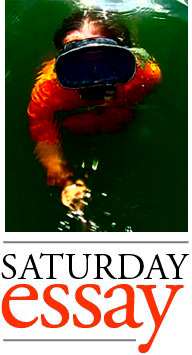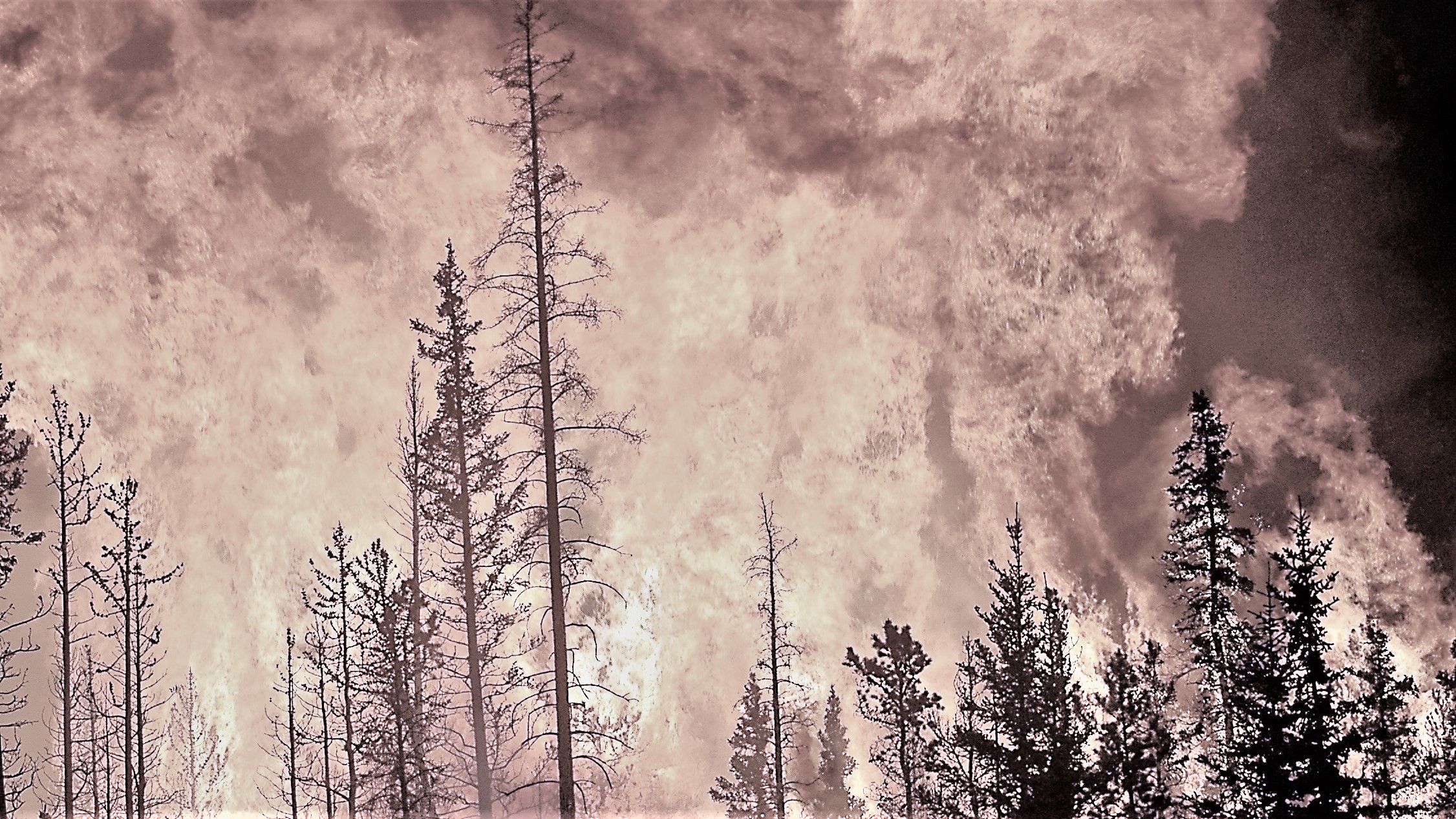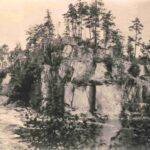I Was Left for Dead at Nopeming Sanatorium in the 1918 Fire
 (Excerpts from Scions of Cloquet by Jean-Michel Cloquet, 1946, out of print)
(Excerpts from Scions of Cloquet by Jean-Michel Cloquet, 1946, out of print)
I was left for dead at Nopeming sanatorium in 1918, as the Cloquet-Duluth-Moose Lake fire combined with World War I, tuberculosis, and the influenza pandemic just hitting the northland. I’d brought my tuberculosis home with me from the filthy trenches of the Somme. There wouldn’t be an armistice for a month. Reaching Duluth, I was trucked on the dirt road to Nopeming with other infected veterans, fresh off the hospital ship. There we met citizens suffering from the homegrown TB outbreak traced to sewage in Lake Superior. That’s the Duluth I returned to. I’d barely survived overseas, evading German flamethrowers. Some of my trench-mates weren’t so lucky. Now I was barely surviving even though I was stateside, too sick to be properly shell-shocked from the omnipresent global crisis. So they tucked us away 10 miles outside of town in the forest sanatorium. Its name is Ojibwe for “in the woods.” The woods that burned.
In those days the grounds had three interconnected buildings for hospital care, administration, and staff dorms. The breezes on our little bluff were said to be curative in the alchemical magic that passed for medicine.
We coughed up spots of blood. With additional flu precautions, the staff increased our isolation, atomizing us into separate spaces and a regime of hospital masks. But along with most, I got the flu anyway. Many died. The last thing I remember is my doctor saying if I couldn’t break the fever, I might lapse into a coma. That was the morning of October 12.
Staff became aware of the fire while trying to figure out if I was dead or not. I don’t hold grudges. A caravan of cars from Duluth ran the gauntlet of racing flames, evacuating patients and staff to the Armory. On a gurney under a sheet in the basement morgue, I missed the ride.
I Awoke Violently
I awoke violently coughing hours later. Naked, delirious, I pulled the sheet from myself in the dark windowless room. Smelled woodsmoke. I found a light switch on the tiled wall but got nothing. Adjusting to the ambient light from a distant stairwell, I saw the sheet that had covered me was stained with the bloody sputum I hacked up. I’d sputtered awake from the spasms of it. The TB, trying to finish me off, awakened me instead.
A tag on my toe misidentified me as deceased. No one around. I considered that I might be dreaming, or condemned to a private hell. I had the sinking feeling of nightmares coming true.
Donning cotton orderly scrubs, I climbed stairs, following hints of light. A wall clock said 4:00 but I couldn’t tell if that meant afternoon or morning. I came to a window hesitantly admitting surreal light. The oversized sun, or moon, hung blood red in an orange haze, a column of black smoke replacing the sky.
Wheezing, coughing blood, I hustled up several flights of stairs until I found the best vantage. An office with generous windows on the top floor revealed the full face of the advancing forest fire. Forest fire is an inaccurate term — it was a firestorm, feasting on decades of logging waste from the industry that built the towns out here.
I grabbed the binoculars that rested on the windowsill. Veins of white pine showed above shorter hardwoods as tornadoes of fire twisted on the horizon. To the west where Brookston should be I saw towers of flame. Carlton would be next. Meanwhile the fire bore down on Duluth to the northeast.
Curtains of flame joined and strengthened as the air itself seemed to burn. The approaching conflagration reached to the sky in a miles-long line.
The Burning Rescue Train
I scanned the Great Northern rail line to the southwest. The flames engulfed the railway on both sides of the gap. Blazes leapt treetop to treetop ahead of the rushing wave front, embers falling like stars.
A comet shot along the tracks, a salient pulling ahead of the thundering wall of fire. It was a caboose, all wood, burning like a torch. As it pierced the veil I saw it heralded an entire train, one of the rescue trains marshalled to evacuate the towns.
The train had hurtled as deeply into the landscape of tinder as it could, boarding fleeing townsfolk along the track until the flames were upon them. Then the engineer and the fireman threw it into reverse and backed out at top speed. But they had waited too long. Full of wailing voices, the boxcars and passenger cars burned like cordwood as the train sped backward out of the apocalypse, racing toward Duluth like an incendiary artillery round.
Before I lost sight of it behind the bluff, the binoculars revealed a final glimpse inside the engineer’s cab of the insane reverse locomotive. The engineer had died upright, scorched hands grafted to the red-hot iron controls. Seeing with burned-out eyes, he’d become a Charon ferrying souls.
A quick-thinking railyard worker intentionally derailed this train of the dead on the outskirts of the city, before it could smash into the Depot and set downtown ablaze. The locomotive’s fireman was found in the engine’s water reservoir where he had shut himself safely away, only to asphyxiate in the clash of elements.
Face to Face with the Wall of Flame
Nopeming was surrounded, the firestorm intent on consuming all things. The windows of the sanatorium shattered one by one spraying half-molten glass shards. I realized the giant red eye was the sun and it was setting. Could the winds ease? I dumped a bucket of water on myself and left the upper floors, flinching at flying glass. I exited onto the lawn’s brown grass, wind blasting dry and hot like I had walked into a solar hurricane.
I stood face to face with the deafening wall of flame. Trees cracked, exploded. Coughing hard, less than half alive, I fell to all fours. My swelling eyes saw blood-flecked grass on the verge of combustion. My scrubs had already completely dried and threatened to ignite. My singeing hair sizzled, skin blistering.
The cyclonic flame flowed around the bluff as Nopeming became the center of a fire tornado about to form. Shadows evaporated as the updraft pulled me to my feet, practically lifting me into the air as the howling forces regarded me from all sides. My cracking lips screamed as if to shatter my throat, “Get it over with!” I’d survived the war to come home and burn to death while dying of disease — facets of my extinction.
But the winds had reached their apex. As they slowly withdrew, the firestorm spun out and I collapsed. The updraft that had kept embers from falling on the grounds released its hold. A silent anti-snow painted the stricken landscape with soft flakes of black ash. Curling up, I let them cover me. One of my shrouds.
(In the aftermath, improbable islands of survivability were identified among the paths of destruction. Nopeming was one of those islands. Jean-Michel Cloquet made a full recovery, with the exception of reduced lung capacity and lifelong dreams of fire.)
An index of Jim Richardson’s work may be found here.
Recommended Links:
Leave a Comment
Only registered members can post a comment , Login / Register Here















1 Comment
Molly Desrosier
about 3 months ago